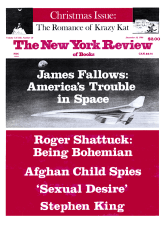In response to:
The Faker's Art from the October 23, 1986 issue
To the Editors:
Joseph Alsop’s “The Faker’s Art” [NYR, October 23] is an artful expansion of sections in his The Rare Art Traditions (Harper and Row, 1982). It is an interesting and imaginative development of passages dealing with fakes, faking, and fakers. In the case of the so-called Grünewald at Cleveland certain corrections are in order—corrections that reinforce his comments on the post-mortem visual effects induced when viewing the exposed forgery.
“Rumors” about Christian Goler were late in surfacing. To the best of my knowledge these rumors were known to me, and those of my colleagues I am acquainted with, well after the fact of exposure. Further, scientific tests of the panel were undertaken before purchase. These were, unfortunately, positive. The most notably reassuring test revealed the presence of tin yellow, a pigment then believed to have been not used after the early nineteenth century at the latest. Technologically all seemed well.
I consulted many of my colleagues, far more expert in the field than myself, before and after acquisition. With one notable exception, the perspicacious Konrad Oberhueber of the Fogg Art Museum, all agreed on the authenticity of the panel. The death knoll came through visual means, a photograph of yet a second of the missing panels of the Mainz altarpiece offered for sale by an unknown Munich dealer. It was patently, obviously and absurdly false. All of the characteristics of the assumed late style of Grünewald were caricatured to a degree far beyond that of the Cleveland panel. This degree was so extreme as to clearly reveal that both were blatant forgeries. Sleepless nights followed as the now re-doubled scientific analysis proceeded until there was no doubt about my error. Then, what to do?
I then met with the vendor, not in “Great indignation,” but with sadness and trepidation. He was a reliable professional and as crestfallen as anyone involved in the case. His reaction was both direct and honorable and resulted in a solution satisfactory to the museum’s wounded pride and depleted pocketbook.
Disillusionment there was. Reflection bred education. And this is what reinforces Alsop’s comments on visual perception. We see what we see, but also what we want to see, or what we do not want to see. Grünewald is a rare and great master. We have a strong German Gothic and early Renaissance collection in Cleveland. Like almost all other American art museums, we had no Grünewald. Ergo—. What could be a neater confirmation of the visual processes rehearsed by Tietze, Gombrich, and Alsop?
The fake hangs in the conservation laboratory of The Cleveland Museum of Art. The memory hangs on a prominent hook in my mind. The memory influences all of my subsequent confrontations with newly seen works of art—all confirming Guglielmo Ferrero’s wonderful statement: “What makes good judgement? Experience. What makes experience? Bad judgement.”
Sherman E. Lee
Chapel Hill, North Carolina
This Issue
December 18, 1986



